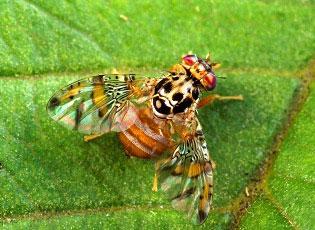Ceratitis capitata (Wiedemann, 1824) (ITIS)
Mediterranean fruit fly, Medfly
Ceratitis citriperda (MacLeay), Ceratitis hispanica (De Brême), Paradalaspis asparagi (Bezzi), Tephritis capitata (Wiedemann) (ITIS)
Sub-Saharan Africa (Silva et al. 2003)
1910 (Hawaii); infestations in the continental U.S. began in 1929 (APHIS 2003; Silva et al. 2003)
Usually through imported fruit and other crops infested with fruit fly larvae (Silva et al. 2003)
Attacks over 200 species of fruits and vegetables (APHIS 2003)

Male medfly resting on a leaf
Scott Bauer, USDA. Agricultural Research Service, Photo Unit
Spotlights
Distribution / Maps / Survey Status
Federally Regulated
All Resources
Selected Resources
The section below contains highly relevant resources for this species, organized by source.
Partnership
Federal Government
International Government
State and Local Government
Academic
APHIS. 2003. Mediterranean Fruit Fly Action Plan [PDF, 556 KB]. USDA, APHIS Plant Protection and Quarantine.
Integrated Taxonomic Information System. Ceratitis capitata. [Accessed Sep 19, 2023].
Silva, J.G., M.D. Meixner, B.A. Mcpheron, G.J. Steck, and W.S. Sheppard. 2003. Recent Mediterranean fruit fly (Diptera: Tephritidae) infestations in Florida: a genetic perspective. Journal of Economic Entomology 96(6):1711-1718.
